10 MIN READ
Factors that Promote Corn Diseases
October 4, 2023
Corn diseases occur every year and can be a major factor limiting corn yield potential. All growth stages and plant parts are susceptible to infection. Corn diseases can cause leaf spots, blights, or wilts that result in premature death of the plant. They can also cause harvest and storage losses and affect grain quality.
There are many types of pathogens that can infect plants and cause diseases resulting in injury and plant loss. These pathogens range from causing seed and seedling diseases, to foliar diseases, to stalk rots and ear rots. Additionally, the pathogens themselves can be microscopic organisms including nematodes, fungi, viruses, and bacteria.
A primary principle of plant disease—or any disease for that matter—is the disease triangle, which states that three things must occur for a pathogen to cause a disease. These three things are 1.) that the pathogen must be present, 2.) the host must be susceptible, and 3.) favorable environmental conditions must exist for the development of the disease (Figure 1). Increasing the amount of time spent in environmental conditions favorable for specific diseases also increases the overall disease pressure. The key to managing any plant disease is to eliminate at least one of the three factors of the disease triangle. As many management tactics and strategies are pathogen specific, it is important to accurately identify the pathogen causing the disease before making management decisions.
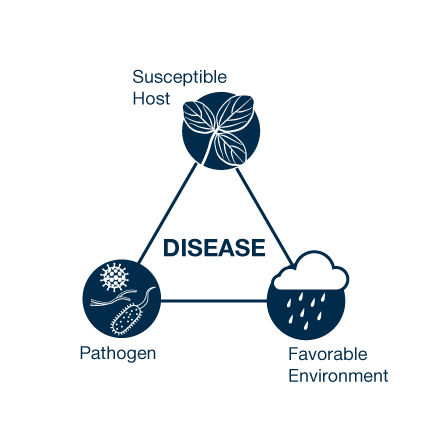
Seed and Seedling Diseases
Seed and seedling diseases (Figure 2) are usually favored by wet soil and cool soil temperatures (below 50 °F, 10 °C). Fungi can cause seedling blights, are usually present in the soil, and can reside in the soil for many years. Most seed corn is treated with fungicides that provide protection against most soilborne diseases. Planting into a well-prepared seedbed with moist, warm soil (above 55 °F, 12 °C) reduces the risk of seed and seedling diseases. See SEEDLING DISEASES OF CORN for more information.
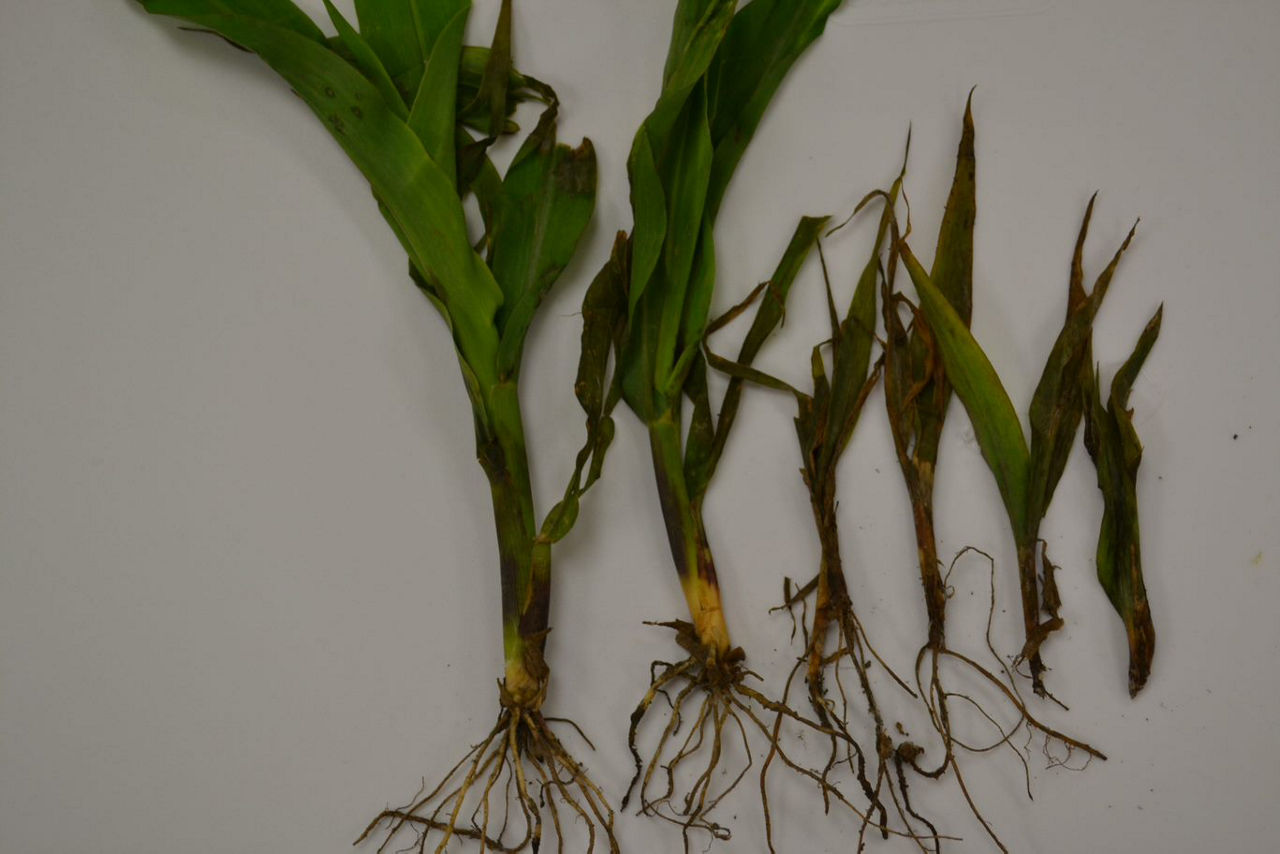
Foliar Diseases
Foliar diseases vary from field to field and year to year depending on environmental conditions, tillage practices, crop rotation, and corn-product susceptibility. In general, moderate temperatures and high moisture (rain or heavy dew) usually favor leaf diseases. More than one disease may be visible on the same plant (Figure 3). Foliar diseases are usually most problematic after tasseling and during grain fill, although all foliar diseases can occur earlier.

Control measures include selection of tolerant corn products, tillage and crop rotation to reduce overwintering pathogen inocula, and timely application of foliar fungicides. See CORN LEAF DISEASES for more information.
Stalk Rots
Late-season stalk rots are common, particularly when stress—such as drought—occurs during the growing season. Most losses from stalk rots involve lost time at harvest and loss of grain, which becomes unharvestable due to the damaged stalks (Figure 4). Several different fungi and bacteria cause stalk rots as part of a group of microorganisms that decompose dead plant material in the soil. These organisms survive from one growing season to the next in soil or on infested corn residue.
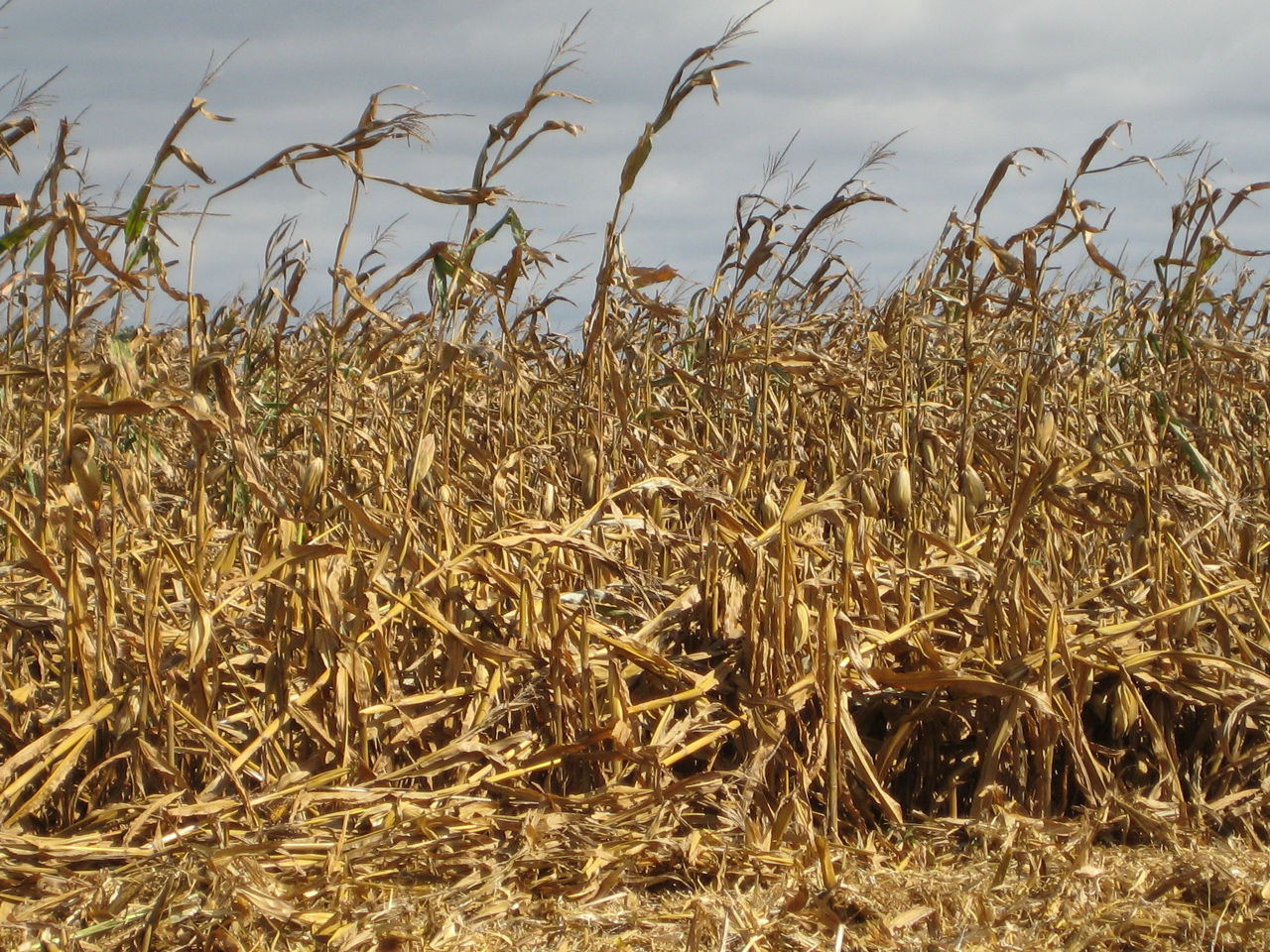
Drought conditions, extended periods of cloudy weather, temperature stress, hail damage, insect damage, nutrient deficiency, leaf loss from foliar diseases, and other stresses can all be associated with an increase in stalk rot.
Prevention of stalk rot is often unsuccessful, as infection by stalk rot organisms is often dependent on factors outside of the producer’s control. However, selecting of corn products with good stalk health and lodging characteristics; maintaining weed, disease, and insect control; practicing proper fertility; planting at appropriate seeding rates for the corn product; and minimizing stress during the reproductive and grain fill stages may reduce the likelihood of stalk rot. For more information see LATE SEASON CORN DISEASE IDENTIFICATION.
Ear Rots
Several fungi cause corn ear and kernel rot diseases that can reduce yield potential, feed quality, and grain value (Figure 5). Most of the ear rots are more prevalent when the amount of rainfall is above average from silking to harvest. One exception is Aspergillus flavus, a pathogen which is favored by drought stress during pollination and by warm temperatures as kernels mature. For all ear rots, damage tends to be more severe on ears with insect, bird, or hail damage. In general, ears that are well covered by husks tend to have less rot than upright ears with open husks. However, Gibberella ear rot seems more severe on ears with tight husks. Some fungi that can cause ear rots—particularly Penicillium, Fusarium, and Aspergillus—can also cause extensive damage to stored grain that is not kept at the proper moisture content and temperature.
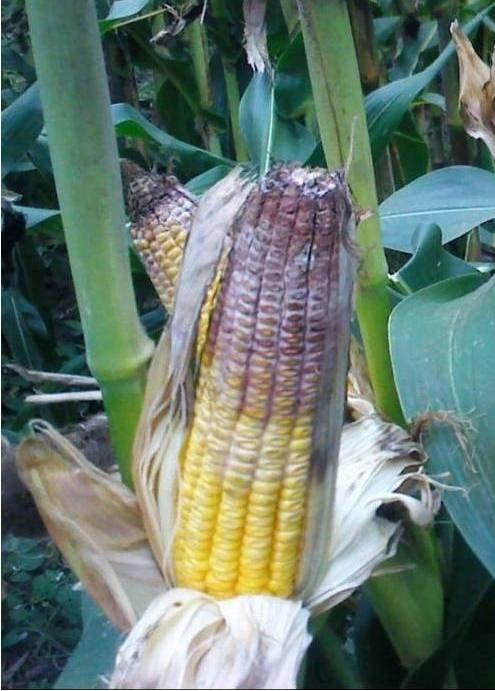
Corn product selection is the primary management option for ear rots. While there are labeled fungicides for ear rots, properly timing their application is critical, and it is difficult to get adequate coverage in the ear region of the corn plant. Early detection of ear rots allows harvest to be prioritized in affected fields and helps reduce the amount of grain affected by the symptoms of the disease.
Nematodes
Nematodes attack corn roots (Figure 6), thereby limiting root development and restricting water and nutrient uptake. There are numerous species of nematodes, including the dagger, lance, lesion, needle, stubby-root, and stunt nematodes. Common symptoms of nematode injuries include yellowing foliage, stunting, swelling, and/or browning of roots. Above-ground symptoms of nematode injury are almost never diagnostic, and usually mimic symptoms of nutrient deficiencies. For more information, see PARASITIC NEMATODES IN CORN.
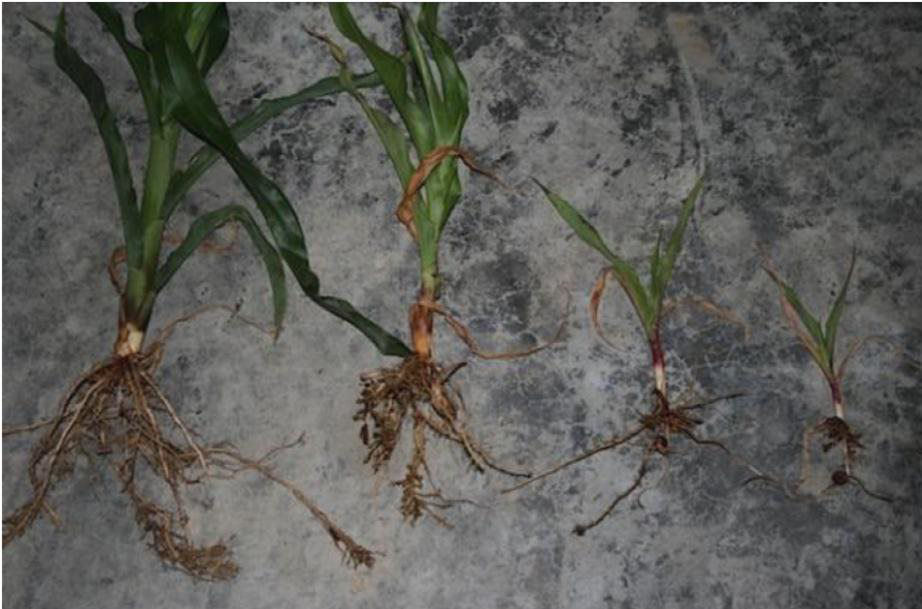
Corn plants are rarely killed by nematodes. Symptoms of nematode feeding are most noticeable when environmental conditions cause plant stress, though nematode injuries can cause yield loss even when plants do not exhibit above-ground symptoms. To identify nematodes, soil and root samples must be taken and submitted to a testing facility. Treatment recommendations can be made after test results confirm the nematode species and population density. Management options vary by species, but include crop rotation, minimizing plant stresses, seed treatments, and nematicides.
Sources:
2023. Disease management in corn. University of Nebraska–Lincoln. Cropwatch. https://cropwatch.unl.edu/plantdisease/corn
2019. Seed decay and seedling blight of corn. Crop Protection Network. https://cropprotectionnetwork.org/encyclopedia/seed-decay-and-seedling-blight-of-corn
Pierce, P. 2018. Ear rots of corn: Telling them apart. Ohio State University Extension. C.O.R.N. Newsletter 2018-18. https://agcrops.osu.edu/newsletter/corn-newsletter/2018-28/ear-rots-corn-telling-them-apart
1211_70129